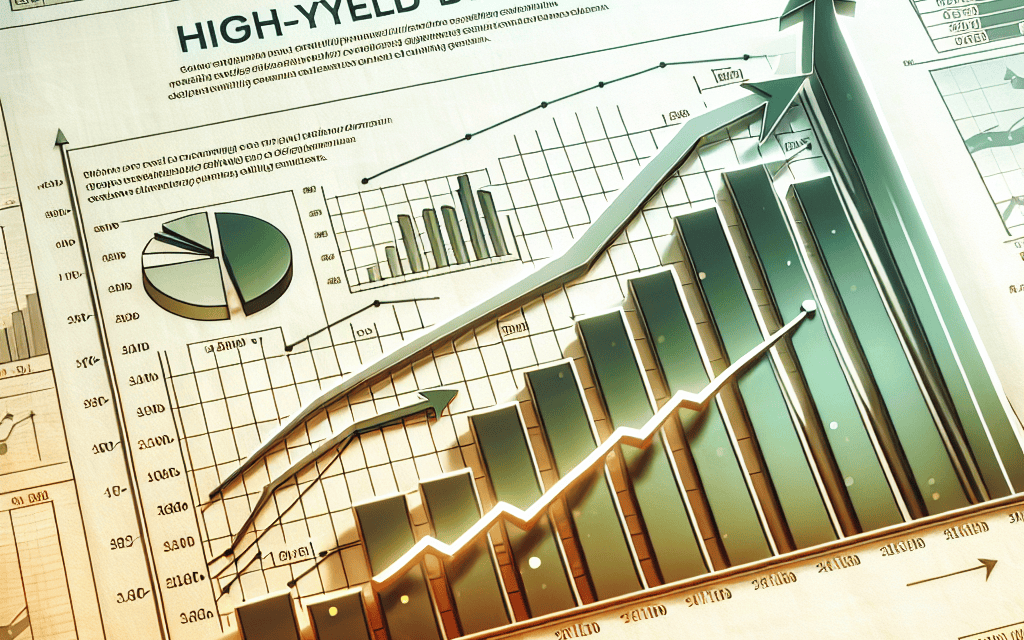“Reaping Rewards: Watch Your Wealth Grow with Steady Climbing Dividends!”
Introduction
“This High-Yield Dividend Continues to Climb Steadily” explores the consistent growth and resilience of a particular dividend stock that has captured the attention of income-focused investors. In an era where market volatility and economic uncertainties often challenge investment strategies, this dividend stands out for its ability to deliver reliable and increasing returns. The article delves into the factors contributing to its steady ascent, including the company’s robust financial health, strategic business decisions, and favorable market conditions. By examining these elements, the piece provides insights into why this high-yield dividend remains an attractive option for those seeking stable and growing income streams in their investment portfolios.
Understanding the Growth Trajectory of High-Yield Dividends
In the ever-evolving landscape of investment opportunities, high-yield dividends have consistently attracted the attention of both seasoned investors and newcomers alike. These dividends, known for providing a steady stream of income, are particularly appealing in times of economic uncertainty. As investors seek stability and growth, understanding the factors contributing to the steady climb of high-yield dividends becomes crucial.
To begin with, high-yield dividends are typically associated with companies that have established a robust track record of profitability and cash flow generation. These companies, often operating in mature industries, prioritize returning capital to shareholders through dividends. This commitment to shareholder returns is a key driver behind the consistent growth of high-yield dividends. Moreover, companies that offer high-yield dividends tend to have strong balance sheets, which enable them to sustain dividend payments even during economic downturns. This financial resilience is a critical factor that underpins the steady climb of these dividends.
Furthermore, the macroeconomic environment plays a significant role in shaping the trajectory of high-yield dividends. In recent years, low interest rates have driven investors to seek alternative sources of income, with high-yield dividends emerging as an attractive option. As traditional fixed-income investments offer diminishing returns, the allure of dividends that provide both income and potential capital appreciation becomes increasingly compelling. This shift in investor preference has contributed to the growing demand for high-yield dividend stocks, thereby supporting their upward trajectory.
In addition to macroeconomic factors, company-specific strategies also influence the growth of high-yield dividends. Many companies have adopted disciplined capital allocation strategies, focusing on optimizing their operations and enhancing shareholder value. By reinvesting in their core businesses and pursuing strategic acquisitions, these companies can generate sustainable earnings growth, which in turn supports higher dividend payouts. This strategic approach not only bolsters the financial health of the company but also instills confidence among investors regarding the reliability of future dividend payments.
Moreover, regulatory and tax considerations can impact the attractiveness of high-yield dividends. In some jurisdictions, favorable tax treatment of dividend income can enhance the net returns for investors, making high-yield dividends an even more appealing investment choice. Additionally, regulatory frameworks that promote transparency and corporate governance can further strengthen investor confidence in companies that offer high-yield dividends. These factors collectively contribute to the sustained growth of high-yield dividends, as they create an environment conducive to long-term investment.
It is also important to consider the role of technological advancements and innovation in driving the growth of high-yield dividends. Companies that successfully leverage technology to improve operational efficiency and expand their market reach are better positioned to generate higher profits. This, in turn, enables them to increase dividend payouts, thereby enhancing the appeal of their stocks to income-focused investors. As technology continues to reshape industries, companies that embrace innovation are likely to remain at the forefront of dividend growth.
In conclusion, the steady climb of high-yield dividends can be attributed to a confluence of factors, including strong company fundamentals, favorable macroeconomic conditions, strategic capital allocation, regulatory considerations, and technological advancements. As investors navigate the complexities of the financial markets, understanding these dynamics is essential for making informed investment decisions. By recognizing the drivers behind the growth of high-yield dividends, investors can better position themselves to capitalize on the opportunities presented by this enduring investment strategy.
Key Factors Driving the Steady Climb of This Dividend
In the ever-evolving landscape of financial investments, high-yield dividends have consistently attracted the attention of investors seeking both income and growth. Among these, one particular dividend has demonstrated a remarkable ability to climb steadily, offering a compelling case study in financial resilience and strategic management. Understanding the key factors driving this steady ascent requires a closer examination of the company’s underlying strategies, market conditions, and broader economic trends.
To begin with, the company’s robust financial health forms the cornerstone of its dividend growth. A strong balance sheet, characterized by manageable debt levels and ample cash reserves, provides the necessary foundation for sustaining and increasing dividend payouts. This financial stability not only reassures investors of the company’s ability to weather economic downturns but also enables it to capitalize on growth opportunities without compromising its dividend commitments. Furthermore, the company’s consistent revenue streams, often derived from diversified business operations, ensure a reliable cash flow that supports ongoing dividend increases.
In addition to financial stability, strategic management decisions play a pivotal role in the dividend’s upward trajectory. The company’s leadership has demonstrated a keen ability to adapt to changing market conditions, implementing innovative strategies that enhance operational efficiency and drive profitability. By investing in technology and streamlining processes, the company has managed to reduce costs and improve margins, thereby freeing up additional resources for dividend distribution. Moreover, strategic acquisitions and partnerships have expanded the company’s market reach and diversified its revenue base, further bolstering its capacity to sustain and grow dividends.
Market conditions also significantly influence the performance of high-yield dividends. In recent years, low interest rates have driven investors to seek higher returns in the equity markets, increasing demand for dividend-paying stocks. This heightened demand has, in turn, supported the stock price, creating a positive feedback loop that benefits both the company and its shareholders. Additionally, the company’s presence in sectors with strong growth potential, such as technology or renewable energy, positions it favorably to capitalize on emerging trends and maintain its competitive edge.
Broader economic trends, such as inflation and monetary policy, also impact dividend growth. In an inflationary environment, companies with pricing power can pass on increased costs to consumers, thereby preserving their profit margins and ability to pay dividends. The company’s strategic positioning in industries with high barriers to entry and strong pricing power has enabled it to navigate inflationary pressures effectively. Furthermore, a favorable monetary policy environment, characterized by accommodative central bank actions, has provided additional support for equity markets and dividend-paying stocks.
In conclusion, the steady climb of this high-yield dividend can be attributed to a confluence of factors, including the company’s robust financial health, strategic management decisions, favorable market conditions, and broader economic trends. By maintaining a strong balance sheet, adapting to market changes, and capitalizing on growth opportunities, the company has positioned itself as a reliable source of income for investors. As the economic landscape continues to evolve, the company’s ability to sustain and grow its dividend will remain a testament to its resilience and strategic foresight, offering valuable insights for investors seeking to navigate the complexities of the financial markets.
Analyzing the Financial Health Behind High-Yield Dividends
In the realm of investment, high-yield dividends often capture the attention of both seasoned investors and newcomers alike, offering a tantalizing promise of steady income. However, the allure of high-yield dividends must be carefully balanced with an understanding of the financial health underpinning these returns. A dividend yield that continues to climb steadily is not merely a product of chance but rather a reflection of a company’s robust financial strategies and sound management practices. To truly appreciate the sustainability of such dividends, one must delve into the financial health indicators that support them.
First and foremost, a company’s ability to maintain and increase its dividend payouts is closely tied to its earnings stability. Companies that consistently generate strong earnings are better positioned to distribute a portion of these profits to shareholders in the form of dividends. This stability often stems from a diversified revenue stream, which mitigates the risks associated with market volatility. For instance, companies operating in essential industries such as utilities or consumer staples tend to exhibit more predictable earnings patterns, thereby supporting a reliable dividend policy.
Moreover, the payout ratio serves as a critical metric in assessing the sustainability of high-yield dividends. This ratio, which compares the total dividends paid to the company’s net income, provides insight into how much of the earnings are being returned to shareholders. A moderate payout ratio suggests that a company is retaining enough earnings to reinvest in growth opportunities while still rewarding its investors. Conversely, an excessively high payout ratio may indicate that a company is overextending itself, potentially jeopardizing future dividend payments if earnings were to decline.
In addition to earnings stability and payout ratios, a company’s cash flow is another vital component in evaluating its financial health. Strong cash flow ensures that a company has the liquidity necessary to meet its dividend obligations without resorting to debt or asset liquidation. Companies with robust cash flow generation capabilities are often better equipped to weather economic downturns, maintaining their dividend payments even in challenging times. This resilience is particularly important for income-focused investors who rely on dividends as a source of regular income.
Furthermore, a company’s balance sheet strength cannot be overlooked when analyzing high-yield dividends. A healthy balance sheet, characterized by low debt levels and ample reserves, provides a cushion against financial uncertainties. Companies with strong balance sheets are less likely to face financial distress, allowing them to sustain or even increase their dividend payouts over time. This financial stability is a testament to prudent management practices and strategic decision-making, which are crucial for long-term dividend growth.
Lastly, it is essential to consider the broader economic environment and industry-specific factors that may influence a company’s dividend policy. Economic conditions, such as interest rates and inflation, can impact a company’s cost of capital and profitability, thereby affecting its ability to pay dividends. Additionally, industry trends and competitive dynamics may also play a role in shaping a company’s financial health and dividend strategy.
In conclusion, while high-yield dividends offer an attractive proposition for investors seeking income, it is imperative to analyze the financial health of the companies behind these dividends. By examining earnings stability, payout ratios, cash flow, balance sheet strength, and external factors, investors can gain a comprehensive understanding of the sustainability of these dividends. This thorough analysis not only helps in making informed investment decisions but also ensures that the promise of high-yield dividends is backed by a solid financial foundation.
The Role of Market Trends in Sustaining Dividend Growth

In the ever-evolving landscape of financial markets, the pursuit of high-yield dividends remains a cornerstone strategy for many investors seeking both income and growth. The ability of a dividend to climb steadily over time is often a reflection of underlying market trends that support and sustain such growth. Understanding these trends is crucial for investors aiming to capitalize on dividend opportunities while mitigating potential risks.
To begin with, one of the primary market trends influencing dividend growth is the overall economic environment. In periods of economic expansion, companies typically experience increased revenues and profitability, which can lead to higher dividend payouts. This is particularly true for sectors that are closely tied to consumer spending and industrial production. As businesses thrive, they are more likely to reward shareholders with increased dividends, thereby contributing to a steady climb in dividend yields. Conversely, during economic downturns, companies may face pressure to cut or suspend dividends to preserve cash, highlighting the cyclical nature of dividend growth.
Moreover, interest rate trends play a significant role in shaping dividend policies. In a low-interest-rate environment, investors often seek higher yields from equities, as traditional fixed-income investments offer limited returns. This increased demand for dividend-paying stocks can drive up share prices, indirectly supporting higher dividend yields. Additionally, companies may be more inclined to raise dividends when borrowing costs are low, as they can finance growth initiatives more cheaply, thereby enhancing their ability to generate future profits and sustain dividend increases.
Another critical factor is the competitive landscape within specific industries. Companies operating in sectors with high barriers to entry and limited competition often enjoy stable cash flows, which can support consistent dividend growth. For instance, utility companies and consumer staples firms typically benefit from steady demand for their products and services, allowing them to maintain and even increase dividends over time. In contrast, industries characterized by rapid technological change or intense competition may experience more volatile earnings, potentially impacting their ability to sustain dividend growth.
Furthermore, corporate governance and management strategies significantly influence dividend policies. Companies with a strong commitment to returning capital to shareholders often prioritize dividend growth as a key component of their financial strategy. This commitment is frequently reflected in a company’s dividend payout ratio, which indicates the proportion of earnings distributed as dividends. A sustainable payout ratio suggests that a company is balancing its dividend payments with reinvestment in growth opportunities, thereby supporting long-term dividend increases.
In addition to these factors, global market trends, such as shifts in trade policies and geopolitical developments, can also impact dividend growth. Companies with significant international exposure may face currency fluctuations and regulatory changes that affect their earnings and, consequently, their dividend policies. However, diversification across different markets can also provide opportunities for growth, enabling companies to tap into emerging markets and expand their revenue base, ultimately supporting dividend increases.
In conclusion, the steady climb of high-yield dividends is intricately linked to a myriad of market trends that collectively shape the financial landscape. By understanding the interplay between economic conditions, interest rates, industry dynamics, corporate governance, and global developments, investors can better assess the sustainability of dividend growth. This knowledge not only aids in making informed investment decisions but also enhances the potential for achieving a balanced portfolio that delivers both income and capital appreciation over time.
Comparing High-Yield Dividends with Other Investment Options
In the ever-evolving landscape of investment opportunities, high-yield dividends have emerged as a compelling option for investors seeking both income and growth. As the financial markets continue to fluctuate, the allure of high-yield dividends becomes increasingly pronounced, especially when compared to other investment avenues. These dividends, often associated with established companies, provide a steady stream of income, which can be particularly appealing in times of economic uncertainty. Moreover, the potential for capital appreciation adds another layer of attractiveness to this investment strategy.
To begin with, high-yield dividends offer a unique combination of income generation and potential for growth, setting them apart from traditional fixed-income investments such as bonds. While bonds are generally considered safe, they often provide lower returns, especially in a low-interest-rate environment. In contrast, high-yield dividends can offer more substantial returns, making them an attractive option for investors looking to maximize their income. Furthermore, the regularity of dividend payments can provide a sense of financial stability, which is often lacking in more volatile investment options like stocks.
Transitioning to the comparison with growth stocks, high-yield dividends present a different risk-reward profile. Growth stocks, characterized by their potential for significant capital appreciation, often come with higher volatility and risk. Investors in growth stocks typically rely on the appreciation of stock prices for returns, which can be unpredictable and subject to market fluctuations. On the other hand, high-yield dividends provide a more predictable income stream, which can be reinvested to compound returns over time. This reinvestment strategy can lead to substantial wealth accumulation, particularly for long-term investors.
Moreover, when considering real estate as an investment option, high-yield dividends offer distinct advantages. Real estate investments, while potentially lucrative, require significant capital and involve various risks, including market downturns and property management challenges. High-yield dividends, however, allow investors to participate in the growth of companies without the need for large capital outlays or the complexities associated with property ownership. Additionally, the liquidity of dividend-paying stocks is a notable advantage, as investors can easily buy or sell shares without the lengthy processes involved in real estate transactions.
In the context of inflation, high-yield dividends also hold their ground. Inflation erodes the purchasing power of fixed-income investments, but companies that pay dividends often have the ability to increase payouts over time, thereby providing a hedge against inflation. This potential for increasing income is a significant benefit that fixed-income investments typically lack. Furthermore, companies that consistently raise their dividends demonstrate financial health and stability, which can be reassuring for investors concerned about economic volatility.
In conclusion, high-yield dividends continue to climb steadily as a preferred investment option for those seeking a balance between income and growth. When compared to other investment avenues such as bonds, growth stocks, and real estate, high-yield dividends offer a compelling mix of benefits. Their ability to provide regular income, potential for capital appreciation, and resilience against inflation make them an attractive choice for a diverse range of investors. As the financial landscape continues to evolve, high-yield dividends remain a steadfast option, offering both stability and opportunity in an uncertain world.
Long-Term Benefits of Investing in Steadily Climbing Dividends
Investing in high-yield dividends has long been a favored strategy among investors seeking both income and growth. The allure of dividends lies in their ability to provide a steady stream of income, which can be particularly appealing in volatile market conditions. Among the myriad of dividend-paying stocks, those that offer steadily climbing dividends stand out as particularly attractive. These stocks not only provide immediate income but also promise potential for long-term capital appreciation, making them a compelling choice for investors with a long-term horizon.
One of the primary benefits of investing in stocks with steadily climbing dividends is the power of compounding. As dividends increase over time, reinvesting them can significantly enhance the overall return on investment. This compounding effect can lead to exponential growth in the value of the investment, especially when held over an extended period. Moreover, companies that consistently raise their dividends often signal financial health and stability, as they demonstrate a commitment to returning value to shareholders. This can be reassuring for investors, as it suggests that the company is generating sufficient cash flow to support both its operations and its dividend policy.
Furthermore, steadily climbing dividends can serve as a hedge against inflation. As the cost of living rises, the purchasing power of fixed income streams diminishes. However, dividends that increase over time can help offset this erosion, providing a growing income stream that keeps pace with or even outstrips inflation. This is particularly important for retirees or those relying on dividend income to meet their living expenses, as it ensures that their income does not lose value in real terms.
In addition to providing income and growth potential, investing in high-yield dividends with a track record of steady increases can also offer a measure of downside protection. During market downturns, dividend-paying stocks tend to be less volatile than their non-dividend-paying counterparts. The regular income from dividends can cushion the impact of falling stock prices, providing a buffer that can help preserve capital. This stability can be particularly valuable during periods of economic uncertainty, when market volatility is heightened.
Moreover, companies that consistently raise their dividends often exhibit strong corporate governance and prudent financial management. These companies typically have robust business models, competitive advantages, and disciplined capital allocation strategies. As a result, they are often better positioned to weather economic challenges and emerge stronger in the long run. This resilience can translate into more stable and reliable returns for investors, further enhancing the appeal of steadily climbing dividends.
In conclusion, the long-term benefits of investing in high-yield dividends that continue to climb steadily are manifold. From the power of compounding and inflation protection to downside risk mitigation and corporate resilience, these investments offer a compelling combination of income and growth potential. For investors seeking a balanced approach that prioritizes both immediate income and long-term capital appreciation, steadily climbing dividends represent a prudent and rewarding strategy. As always, it is essential for investors to conduct thorough research and consider their individual financial goals and risk tolerance before making investment decisions. Nonetheless, the enduring appeal of steadily climbing dividends remains a testament to their value as a cornerstone of a well-diversified investment portfolio.
Expert Insights on the Future of High-Yield Dividend Growth
In the ever-evolving landscape of investment opportunities, high-yield dividends have consistently attracted the attention of both seasoned investors and newcomers alike. These dividends, known for providing a steady stream of income, are particularly appealing in times of economic uncertainty. Among the myriad of options available, one high-yield dividend stands out for its remarkable and consistent growth trajectory. This particular dividend has not only maintained its yield but has also demonstrated a steady climb, making it a focal point for expert analysis and investor interest.
To understand the factors contributing to this dividend’s impressive performance, it is essential to consider the broader economic context. In recent years, low interest rates have driven investors to seek alternatives to traditional fixed-income securities. High-yield dividends have emerged as a viable option, offering attractive returns while mitigating some of the risks associated with more volatile investments. This shift in investor preference has provided a fertile ground for certain dividends to flourish, particularly those backed by companies with strong fundamentals and robust cash flow.
The company behind this high-yield dividend has consistently demonstrated financial resilience, even in the face of economic headwinds. Its ability to generate substantial cash flow has enabled it to not only sustain but also increase its dividend payouts over time. This financial strength is underpinned by a diversified business model that mitigates risks associated with market fluctuations. By strategically expanding its operations and tapping into emerging markets, the company has positioned itself for long-term growth, further bolstering investor confidence.
Moreover, the management’s commitment to shareholder value is evident in its prudent capital allocation strategies. By prioritizing investments that yield high returns and maintaining a disciplined approach to debt management, the company ensures that its dividend remains sustainable. This focus on financial health and strategic growth has not gone unnoticed by market analysts, who frequently highlight the company’s dividend as a model of stability and reliability.
In addition to the company’s internal strengths, external factors have also played a role in the dividend’s upward trajectory. The global economic recovery, albeit uneven, has provided a tailwind for industries in which the company operates. As consumer demand rebounds and supply chain disruptions ease, the company’s revenue streams are expected to strengthen further. This positive outlook is reflected in analysts’ forecasts, which predict continued dividend growth in the foreseeable future.
However, it is important to acknowledge potential challenges that could impact the dividend’s growth. Geopolitical tensions, regulatory changes, and unexpected economic downturns remain pertinent risks that could affect the company’s performance. Nevertheless, the company’s proactive risk management strategies and adaptive business practices provide a level of assurance that it is well-equipped to navigate such uncertainties.
In conclusion, the steady climb of this high-yield dividend is a testament to the company’s robust financial health, strategic foresight, and commitment to shareholder value. As investors continue to seek reliable income sources in an unpredictable economic environment, this dividend stands out as a compelling option. While challenges remain, the company’s track record of resilience and growth offers a promising outlook for the future. As such, it remains a subject of keen interest and analysis among experts and investors alike, who recognize its potential to deliver sustained returns in the years to come.
Q&A
1. **What is a high-yield dividend?**
– A high-yield dividend refers to a stock that pays a higher-than-average dividend compared to other stocks, often providing a steady income stream to investors.
2. **Why is a steadily climbing dividend attractive to investors?**
– A steadily climbing dividend indicates a company’s strong financial health and commitment to returning value to shareholders, making it attractive for income-focused investors.
3. **What factors contribute to a company’s ability to increase its dividend?**
– Factors include consistent revenue growth, strong cash flow, a sustainable payout ratio, and prudent financial management.
4. **How does a high-yield dividend impact a stock’s total return?**
– A high-yield dividend can significantly enhance a stock’s total return by providing regular income in addition to any capital appreciation.
5. **What risks are associated with high-yield dividends?**
– Risks include potential dividend cuts if the company faces financial difficulties, interest rate changes affecting stock prices, and market volatility.
6. **How can investors assess the sustainability of a high-yield dividend?**
– Investors can assess sustainability by analyzing the company’s payout ratio, cash flow stability, debt levels, and historical dividend growth.
7. **What is an example of a sector known for high-yield dividends?**
– The utilities sector is known for high-yield dividends due to its stable cash flows and essential services, making it a popular choice for income investors.
Conclusion
The high-yield dividend in question demonstrates a consistent upward trajectory, indicating strong financial health and effective management within the company. This steady climb suggests that the company is generating sufficient cash flow to support and potentially increase its dividend payouts, making it an attractive option for income-focused investors. The reliability of the dividend growth also reflects positively on the company’s operational stability and its commitment to returning value to shareholders. However, investors should continue to monitor the company’s financial performance and market conditions to ensure the sustainability of this trend.





